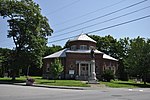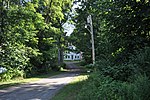Norridgewock

Norridgewock was the name of both an Indigenous village and a band of the Abenaki ("People of the Dawn") Native Americans/First Nations, an Eastern Algonquian tribe of the United States and Canada. The French of New France called the village Kennebec. The tribe occupied an area in the interior of Maine. During colonial times, this area was territory disputed between British and French colonists, and was set along the claimed western border of Acadia, the western bank of the Kennebec River. Archaeological evidence has identified several different sites associated with the settlement known as Norridgewock. The last one, where the French Jesuit priest Sebastian Rale had a mission, is today called Old Point, and is located in Madison. Other sites are located nearby in Starks and the present-day town of Norridgewock. Three of these historically and archaeologically significant areas have been collectively designated as the Norridgewock Archaeological District, a National Historic Landmark District.
Excerpt from the Wikipedia article Norridgewock (License: CC BY-SA 3.0, Authors, Images).Norridgewock
Father Rasle Road,
Geographical coordinates (GPS) Address Nearby Places Show on map
Geographical coordinates (GPS)
| Latitude | Longitude |
|---|---|
| N 44.767 ° | E -69.8833 ° |
Address
Father Rasle Road 504
04957
Maine, United States
Open on Google Maps






